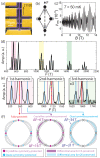Quasi-symmetry protected topology in a semi-metal
- PMID: 35855397
- PMCID: PMC7613062
- DOI: 10.1038/s41567-022-01604-0
Quasi-symmetry protected topology in a semi-metal
Abstract
The crystal symmetry of a material dictates the type of topological band structures it may host, and therefore symmetry is the guiding principle to find topological materials. Here we introduce an alternative guiding principle, which we call 'quasi-symmetry'. This is the situation where a Hamiltonian has an exact symmetry at lower-order that is broken by higher-order perturbation terms. This enforces finite but parametrically small gaps at some low-symmetry points in momentum space. Untethered from the restraints of symmetry, quasi-symmetries eliminate the need for fine-tuning as they enforce that sources of large Berry curvature will occur at arbitrary chemical potentials. We demonstrate that a quasi-symmetry in the semi-metal CoSi stabilizes gaps below 2 meV over a large near-degenerate plane that can be measured in the quantum oscillation spectrum. The application of in-plane strain breaks the crystal symmetry and gaps the degenerate point, observable by new magnetic breakdown orbits. The quasi-symmetry, however, does not depend on spatial symmetries and hence transmission remains fully coherent. These results demonstrate a class of topological materials with increased resilience to perturbations such as strain-induced crystalline symmetry breaking, which may lead to robust topological applications as well as unexpected topology beyond the usual space group classifications.
Conflict of interest statement
Competing Interests The authors declare that they have no competing financial interests.
Figures




References
-
- Armitage NP, Mele EJ, Vishwanath A. Weyl and Dirac semimetals in three-dimensional solids. Rev Mod Phys. 2018;90:015001
-
- Lv BQ, Qian T, Ding H. Experimental perspective on three-dimensional topological semimetals. Rev Mod Phys. 2021;93:025002
-
- Wan XG, Turner AM, Vishwanath A, Savrasov SY. Topological semimetal and Fermi-arc surface states in the electronic structure of pyrochlore iridates. Phys Rev B. 2011;83:205101
-
- Wang Z, Alexandradinata A, Cava RJ, Bernevig BA. Hourglass fermions. Nature. 2016;532:189–194. - PubMed
-
- Bradlyn B, Cano J, Wang Z, Vergniory MG, Felser C, Cava RJ, Bernevig BA. Beyond Dirac and Weyl fermions: Unconventional quasiparticles in conventional crystals. Science. 2016;353:aaf5037. - PubMed
Grants and funding
LinkOut - more resources
Full Text Sources
Miscellaneous
